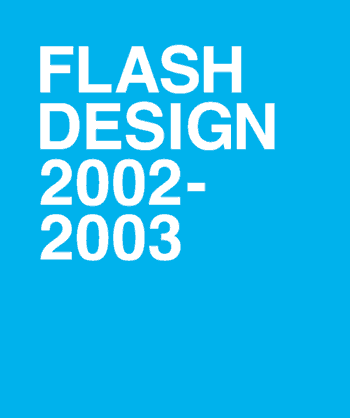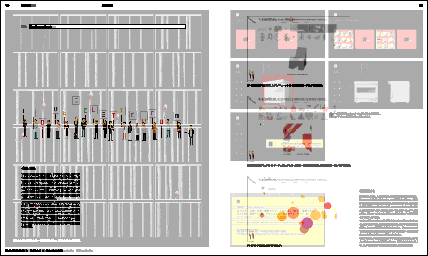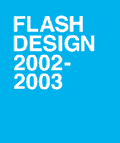FLASH DESIGN 2002-2003
THINGSText: Matt Owens
A book for all Flash users and creators is released this autumn. The book, called “Flash Design 2002-2003”, is edited by Shift and art directed by Hideki Inaba. Flash is now an essential tool to interactively express your designs in the latest web design. Superb sites made with Flash are visually introduced in “Flash Design 2002-2003.”

A hundred sites were chosen from within Japan and abroad. They are divided into 10 categories, such as “MOTION”, “NAVIGATION”, “STYLE”, “ANIMATION” and “GAME” and a special feature of each site is introduced with an explanation.

A CD-ROM, which contains SWF files and FLA files, is attached to this book. Not only as a guide for Flash beginners but also as a step-up book for Flash users, this book is recommended for all creators who are interested in web and design.
As following the opening text by Matt Owens.
Flash is not just a piece of software anymore. Its not merely a piece of software you just install on your machine and you make things with. Flash has become a culture of creative image and experience making in and of itself. In a way, Flash is a piece of software that has become a great creative equalizer – simple enough for the beginner, but robust enough for the action script pro. The balance of complexity and simplicity is what makes flash an engaging and fun tool to use. From illustrators to coders, from gamers to musicians, from artists to designers, Flash provides a common tool and a common language to share and converse within. It is this common culture that have grown around Flash that makes it a unique phenomenon in the internet environment. An international array of creative individuals have been brought together through personal Flash experimentation. It is this culture of experimentation that has made flash visible to the masses and it is through experimental project that flash has grown to prominence.
Some people ask why? Why not another application? What about Macromedia’s Director software? What makes Flash so special? It is the open ended quality and the imperfections within the software that make it interesting to use. Web designers use Flash to figure out how to make it do things that it was not intended to do. Trying out different ways to build ideas in an effort to discover ‘what makes something tick’ makes Flash a unique creative process. You may often see a Flash piece online and wonder exactly how something was created, excited and curious about what you are seeing. This “How did you do that?” aspect of experiencing Flash projects encourages learning and discovery not only on the part of the person experiencing the project, but on the part of other Flash designers that want to learn new ways to do things.
It is not uncommon for me to receive an email asking how I did something and I am often more than happy to send a Flash file in return to help explain. This process of trading and sharing code promotes learning and discovery. this process happens between people on a global scale, without borders and brings individuals with diverse interests together with a desire to do more. An artist in London may email a Flash designer in the US about something they saw online. They both may know the same DJ in Amsterdam and be using mp3s of his or her music. They may use Flash to do a collaborative project together and post it online to share with the world, beginning the process again.
The web space as a medium remains challenging an complex. Innovations happen overnight and new software solutions come and go. For the last 5 years, Flash has steadily built up is presence online, blending both interactivity, animation and content. It is this fusing of interactivity and the cinematic the makes Flash a unique development environment. Design and development through Flash steps out of the web space and the simple presentation of information into the designing of user experiences. Images, editorial and sound come together to produce intimate online experiences that are a new kind of media hybrid.
Flash allows creative individuals to produce art and design that is neither a web site, book, TV show or a video game. But, by the very nature of Flash as a creative tool, projects can possess qualities of all these mediums. It is this fusion of media qualities that makes a successful Flash project challenging to produce and engaging to experience. As we look to the future, the merging of media will become the common thread that holds media experiences together. Sooner than we think, designers will be producing graphic engines that can be captured and incorporated into a broadcast pieces as easily as a poster. Design and creativity will become media agnostic, moving from the big screen to the small screen to the printed page more seamlessly than ever before. Flash is the starting point for this new wave of creativity and form making. Flash empowers designers to think ‘between’ media to learn how images, audio, editorial, video and interactivity can all work in harmony together.
The vector based nature of Flash and its fundamental balance of powerful functionality and ease of use has made it a tool that opens doors for every online creative. From the largest of ad agencies to the student just beginning to produce content online, Flash serves as a great foundation to learn and grow. As we enter the age of broadband, the future holds many tall challenges as well as exciting opportunities for Flash designers. As our mass market mediums blur and as technology advances Flash will be a crucial tool that helps define how content production and visual communications are created. Fortunately for us all, the culture of like minded talents, globally connected and hungry to innovate, stand ready for the opportunities and discoveries that await.

Flash Design 2002-2003
Release date: 22 August 2002
A special A4 size / 4C / 200 pages / with a CD-ROM
Note: the book is written in Japanese only
ISBN: 4-7561-4124-2
Price: 2800 yen (tax in)
Text: Matt Owens




